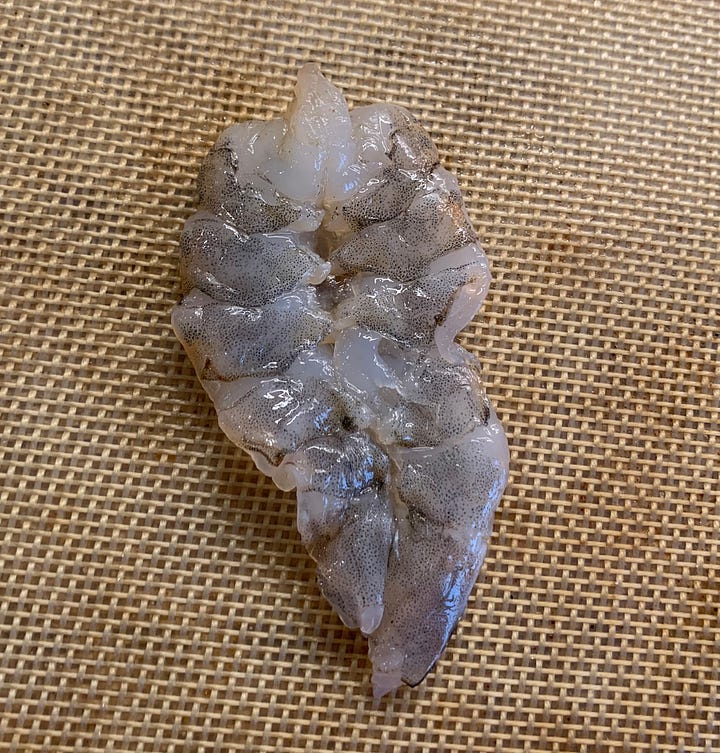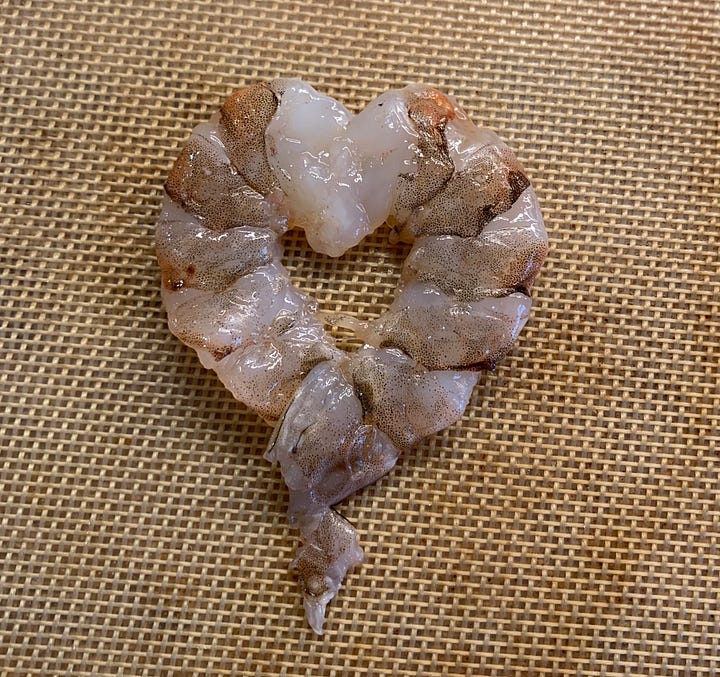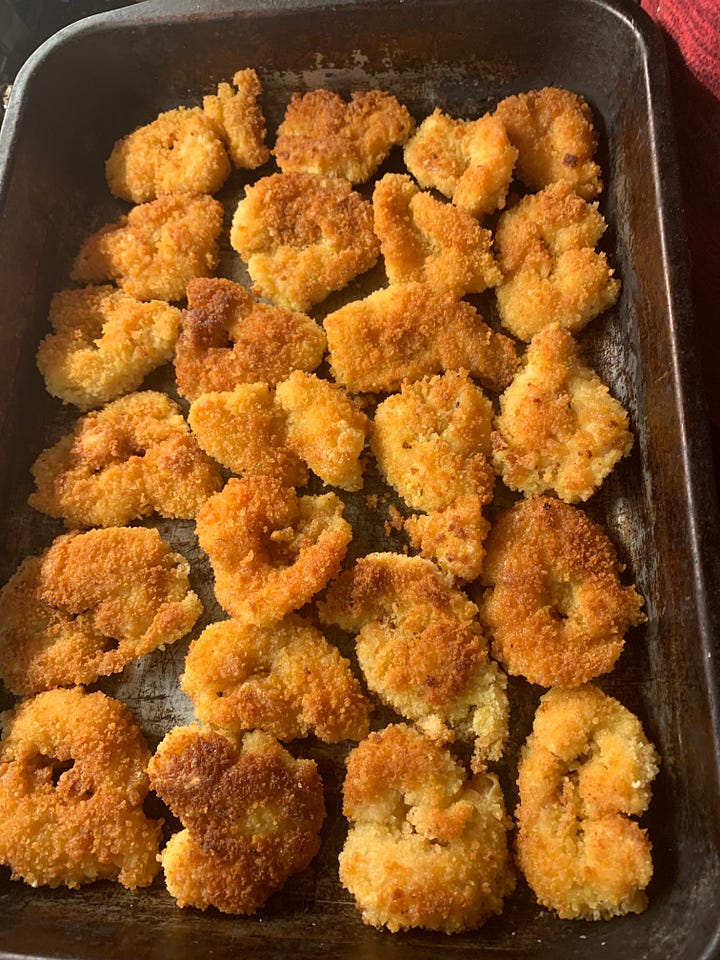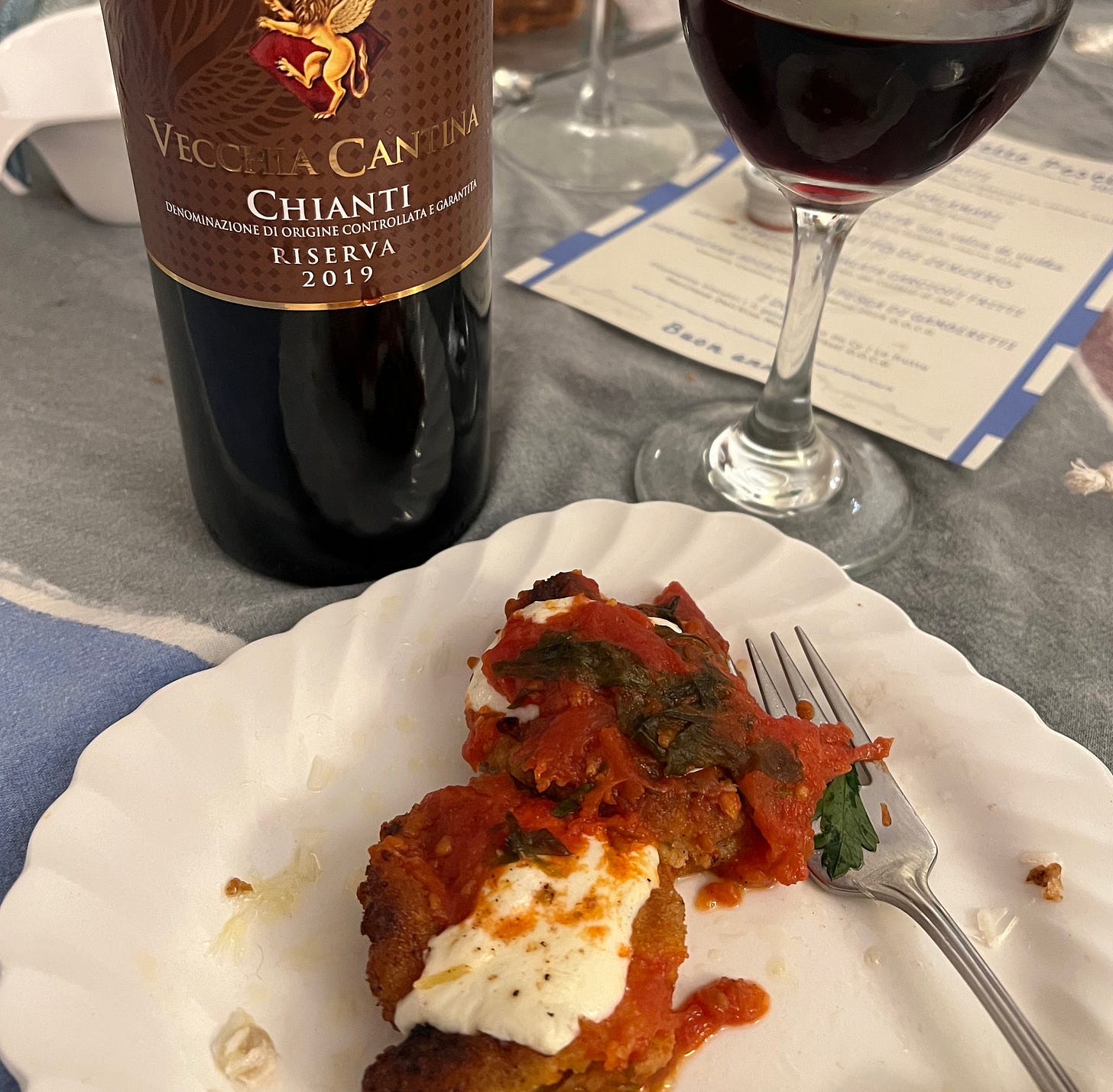Gamberi alla Parmigiana // Shrimp Parm(igiana)
Because one day what's new will inevitably be old and it will taste just as good either way
It has finally arrived, the moment you have all been waiting for: the final course.
Well, not quite the final course. There still remains dessert. So I amend my statement.
The final fish.
If we are being honest with one another, I struggled with what to write for this particular dish. My mom calls shrimp parm “the main event.” It’s always the last course before dessert, and when she was growing up, that’s what every other course led up to. Some family members who have streamlined their fish dinners to combine tradition with simplicity that doesn’t involve preparing a seven course meal have even elected to only make the shrimp parm — that’s how central it is to our family and our meal. The Big Fish.
I found myself disagreeing with her for the first time on something related to food. For me, shrimp parm is not the main event. It’s an afterthought.
Of course, I love shrimp parm. It’s warm, crispy, gooey, tender, savory, and so extraordinarily tasty. I also don’t refute the importance it holds within our family. However, the course I always anxiously awaited when I was growing up was the ravioli. My fish dinner pacing map involved shoving my face while ensuring that I saved just enough room for 8-10 pieces of ravioli and a singular shrimp so I could fit in all seven fish. Thus would conclude my annual fish frenzy that would soon be followed up with at least nine hours of sleep.
Maybe our disconnect in opinion has emerged because Aunt Anne never made the lobster ravioli, and our inclusion of that dish made it so that there are two main events. Thus, the fish dinner club has been cleaved in two — those that await the ravioli, and those that await the shrimp parm. My mom, obviously, remains in the shrimp parm camp — she decides the meal order and that’s the last dish, as it has been since she was a little girl. My main dish will always be the ravioli. For me, there’s no competition. This is aided by the fact that I posses no strongly entrenched memories that prevent me from considering ravioli just as, if not more, central to our dinner than the shrimp.
Yet when I was talking to my mother about the dilemma that was determining what to write for this post, she spilled what I think is the juiciest family secret since learning that a “dandy English fisherman/tourist” happened into a small Norwegian village over a century ago and my great great great paternal grandfather could, in fact, be English instead of Norwegian. Apparently, Philomena never included shrimp parm in her fish dinners. That was developed and perfected by her daughter, Anne.
Anne, I believe, suffered deeply her whole life due to serious strokes of genius. Her choice to add the shrimp serves as stone-cold, solid proof. This ailment must run in the family, as why else would my mother ever think to put lobster in ravioli and throw it on the table?
It was just a disconcerting revelation. Going into this project, I thought these were all closely guarded family recipes that stretched back to the stone ages. While some of that is true (although if “closely guarded” was ever the intention, my ancestors are now looking down (or up) at me in both horror and shame), I just never really considered the fact that what is now tradition could’ve once been innovation.
Perhaps innovation is the wrong term. This shrimp parm is still a tried and true family recipe, the timeline for which it joined our tables was just different than I had initially believed.
I’m growing to realize that this is what family tradition should be: keeping the love is vital, but the exact form in which it is conveyed should be allowed change and adapt. It isn’t doing any disservice to our ancestors to spice things up a bit — it’s just ensuring that our descendants will have something beautiful that reminds them of someone else. Maybe some day my great grandchildren will be making “Philomena’s baccala” and “Anne’s shrimp parm” and “Carrie’s ravioli” alongside “X13OL’s bumblebee fritters.” (Yes, in some states, bees can be classified as fish). That certainly makes me feel a lot better than thinking they will have simply stopped doing it at all.
All that to say, this is a lovely dish to be enjoyed at any time of the year — in fact, it is often enjoyed more when you aren’t already full when you begin to eat. Regardless, it will serve as a not so shrimpy shrimp finale for any company you decide to make it for.
Disclaimer: As with most cooking, these recipes are all to taste. We’ve provided rough estimates for ratios, but feel free to adjust it to your own taste/needs — you’re cooking, so make something you’d like to eat!
Shrimp Parmigiana
Timing: 2 hours prep, 45 minutes cooking
Ingredients/materials:
4 lbs. of shrimp
1-2 cups of bread crumbs
5 eggs
1-2 cups of flour
Canola oil (enough for frying)
2 lbs. mozzarella cheese
106 oz of whole, peeled tomatoes (we use Nina’s)
1/2 cup of olive oil
4 cloves of garlic, thinly sliced
3 tbsps of basil
5 sprigs of Italian flat leaf parsley
1 tbsp salt
1/2 tbsp black pepper
Paring knife, skillet/frying pan, spatula, large pot
Directions:
Remove the shrimp shells by squeezing at the base of the tail and pulling. Then, butterfly the shrimp with a paring knife.
Cut a line down the back side of the shrimp, making sure you don’t cut all the way through. Devein as you go, removing the black line that runs along the underside.
Once the shrimp is cleaned and cut, beat it with a rolling pin or mallet so it flattens.


Left image is the goal — try to avoid holes when cutting, but embrace the heart if it happens Grab three separate bowls. Put flour into the first, eggs into the second, and breadcrumbs into the third. Beat the eggs until evenly mixed.
Put your skillet on medium heat and pour in canola oil.
Dip the shrimp in the flour, the eggs, and the breadcrumbs (in that order) and place them flat into the oil. Flip when the bottom is light brown, cooking until both sides are golden and crispy. Repeat until all shrimp are fried.
Once all shrimp have been cooked, line them up tightly in a greased baking dish. Place some mozzarella over each piece of shrimp.


Preheat the oven to 375ºF.
Lightly brown the garlic in the olive oil in a large pot. While that’s cooking, pour the tomatoes in a food processor or blender and process briefly — about 3 seconds. If they go too long they will turn pink — you want to stop when they are red, just barely broken up.
Add the blended tomatoes to the oil and stir. Add in parsley, basil, salt, and pepper. Let it boil then turn off the heat.
Pour the sauce over the cheesed shrimp. Save some sauce to pour on it once it’s baked, as the tomatoes will dry up in the heat. Put the dish into the oven and bake until the cheese has melted and the sauce is dark red, about 10-15 minutes. Pour on some reserved sauce when it has been plated. Enjoy!
Notes:
When frying, the oil may start to turn black. If this happens, change out the oil in between batches.
Cleaning the shrimp is laborious and time consuming. Just be emotionally prepared.
Buon appetito!






Ahh -- the infamous Shrimp Parmesan that was discussed while commuting to / from many musical gigs by John & your parents!!! John made this dish every New Year's Eve until the end; I, on the other hand, have trouble spending long lengths of time in the kitchen...so I cheat and take short cuts!!! Glad to see this blog, Ella -- best to you and your family!
So pretty!!